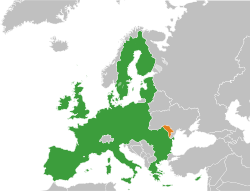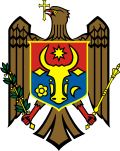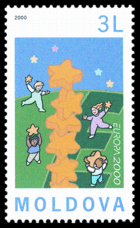- Moldova–European Union relations
-
Euro-Moldovan relations 

European Union
MoldovaMoldova 
This article is part of the series:
Politics and government of
MoldovaConstitutionParliamentJudiciaryExecutiveDivisionsElectionsForeign policy
 A 2000 stamp celebrating 50 years of the Schuman Declaration
A 2000 stamp celebrating 50 years of the Schuman Declaration
Relations between Moldova and the European Union (EU) are currently shaped via the European Neighbourhood Policy (ENP), a foreign policy instrument of the EU designed for the countries it borders.
Moldova has strong ties to EU member Romania and Romanian passports (for EU citizenship) are often granted by Romania to Moldovan citizens. The Republic of Moldova actively pursues EU membership,[1][2] but it is poorer than any other European country and has to resolve issues over its break away region of Transinistra before it can join.
Nevertheless, the EU is developing an increasingly close relationship with Moldova, going beyond co-operation, to gradual economic integration and a deepening of political co-operation[3] The EU has opened an office in Chişinău (the Moldovan capital), and appointed on March 23, 2005, a special representative, Adriaan Jacobovits de Szeged, to Moldova to focus on the resolution of the crisis in Transnistria. The European Commission opened up a new office in Moldova on October 6, 2005, headed by Cesare de Montis. The major strategic priority of Moldova now is membership in European institutions.[1]
Contents
Agreements
Moldova is implementing its first three-year Action Plan within the framework of the ENP of the EU.[4]
The Partnership and Cooperation Agreement (PCA) represents the legal framework for the Republic of Moldova – European Union relationship. The Agreement was signed on 28 November 1994 and entered into force on 1 July 1998 for the next 10 years. This arrangement provides for a basis of cooperation with the EU in the political, commercial, economic, legal, cultural and scientific areas.
The EU Moldova Action Plan[5] is a political document laying out the strategic objectives of cooperation between Moldova and the EU. It covers a timeframe of three years. Its implementation will help fulfil the provisions in the Partnership and Cooperation Agreement (PCA) and will encourage and support Moldova’s objective of further integration into European economic and social structures. Implementation of the Action Plan will significantly advance the approximation of Moldovan legislation, norms and standards to those of the European Union.
Delegation
Main article: Delegation of the European Union to MoldovaThe Delegation of the European Union to Moldova was opened in Chişinău in October 2005, having the status of a diplomatic mission and officially represents the EU in the Republic of Moldova.
Delegations such as the one in Moldova exist all over the world. Altogether there are over 136.
The Delegation's mandate includes:
- Promotion of the political and economic relations between the countries of accreditation and the European Union;
- Monitoring the implementation of the Partnership and Cooperation Agreements (PCA) between the EU and Moldova;
- Informing the public of the development of the EU and to explain and defend individual EU policies;
- Participating in the implementation of the EU's external assistance programmes (mainly TACIS, FSP, ENPI), focusing on the support of democratic development and good governance, regulatory reform and administrative capacity building, poverty reduction and economic growth.[6]
Alliance For European Integration
In August 2009, four Moldovan parties agreed to create a governing coalition, called Alliance For European Integration. The Liberal Democratic Party, Liberal Party, Democratic Party, and Our Moldova have committed themselves to achieving such goals as European integration and promoting a balanced, consistent and responsible foreign policy.[7]
See also
References
- ^ a b Moldova and EU on the official Moldova site
- ^ Moldova will prove that it can and has chances to become EU member, Moldpress News Agency, June 19, 2007
- ^ [1]
- ^ Moldova-EU Action Plan Approved by European Commission, 14 December 2004, retrieved 2 July 2007
- ^ EU-Moldova Action Plan
- ^ The Delegation's of the European Commission to Moldova Mandate
- ^ http://euobserver.com/9/32095
External links
- europa.eu foreign relations Moldova-EU
- Delegation of the European Commission to Moldova site
- www.mfa.md - Ministry of Foreign Affairs and European Integration of Moldova RM-EU relations page
- EU-Moldova Negotiations: what is to be discussed, what could be achieved? document
 Foreign relations of Moldova
Foreign relations of Moldova
 Foreign relations of the European Union
Foreign relations of the European UnionBilateral relations Africa & ME Cape Verde · Iran · Iraq · Israel · Jordan · Lebanon · Morocco · Palestine · South Africa · Syria · Yemen
Americas Asia-Pacific Australia · China (People's Republic of) · Fiji · India · Indonesia · Japan · Nepal · North Korea · Pakistan · South KoreaEurope &
Central AsiaAlbania · Andorra · Armenia · Azerbaijan · Belarus · Bosnia and Herzegovina · Croatia · Cyprus (Turkish Republic of)† · Faroe Islands · Georgia · Iceland · Kazakhstan · Kosovo† · Liechtenstein · Macedonia‡ · Moldova · Monaco · Montenegro · Norway · Russia · San Marino · Serbia · Switzerland · Turkey · Ukraine · Vatican CityGeneral † = Disputed state, may not be recognised as an independent state by some or all European Union or United Nations members. ‡ Name disputed by Greece, EU recognises the Republic of Macedonia as the former Yugoslav Republic of Macedonia.Multilateral relations and initiatives Organisations Initiatives African, Caribbean and Pacific Group of States · Asia–Europe Meeting · Customs Union · Eastern Partnership · Energy Community · Euro-Latin American Parliamentary Assembly · European Common Aviation Area · European Economic Area · Euro-Mediterranean free trade area · Euromediterranean Partnership · Euronest · Economic Partnership Agreements · Neighbourhood Policy · Northern Dimension · Mediterranean Union · Stabilisation and Association Process · Association AgreementOrganisation Policy Common Foreign and Security Policy · Economic Relations · Everything but Arms · Security and Defence Policy · EnlargementActors ECHO · EuropeAid · External Action Service · Foreign Affairs Council · High Representative Catherine Ashton · Parliamentary Foreign Affairs Committee · Foreign Policy Instruments ServiceDiplomatic missions Military and security Initiatives Defence Initiative · Synch. Armed Forces Europe · Defence Procurement · Petersberg tasks · Helsinki Headline GoalStructures Political and Security Committee · Military Committee · Military Staff · Operations Centre · Security & Defence College · Defence Agency · Institute for Security Studies · Satellite Centre · Joint Situation CentreForces Categories:- Third country relationships with the European Union
- Moldova and the European Union
Wikimedia Foundation. 2010.
